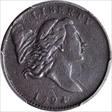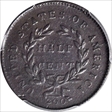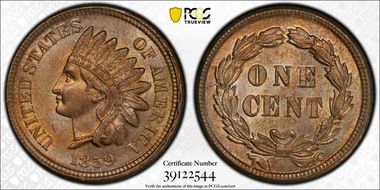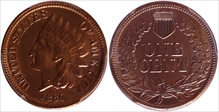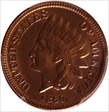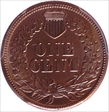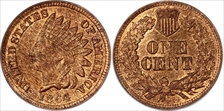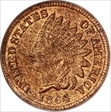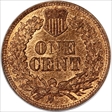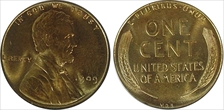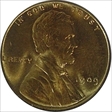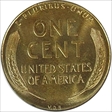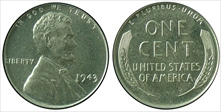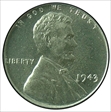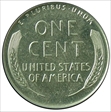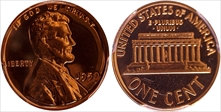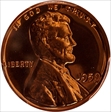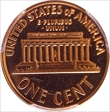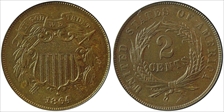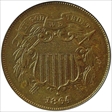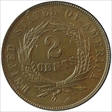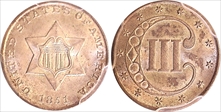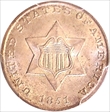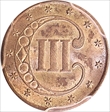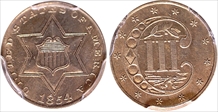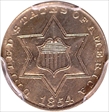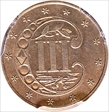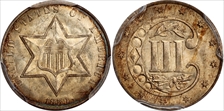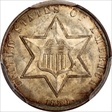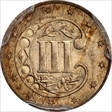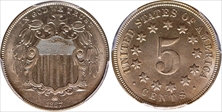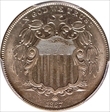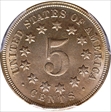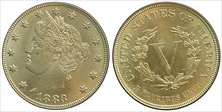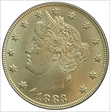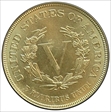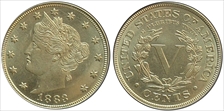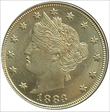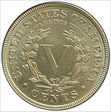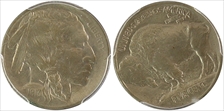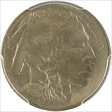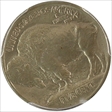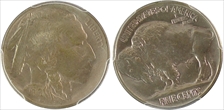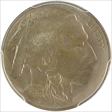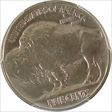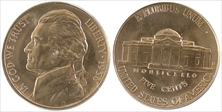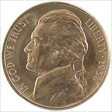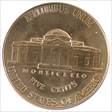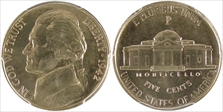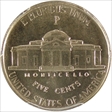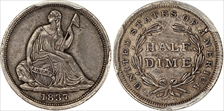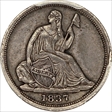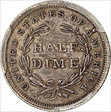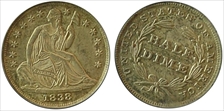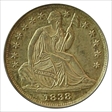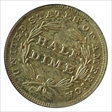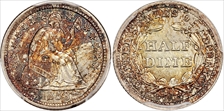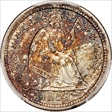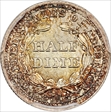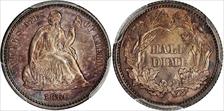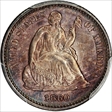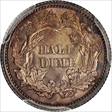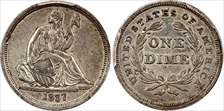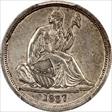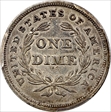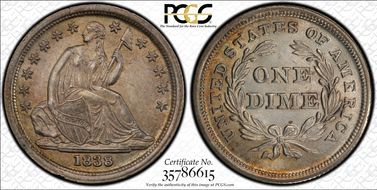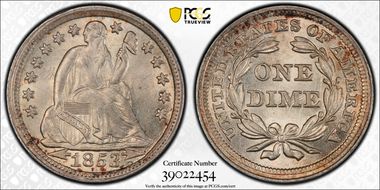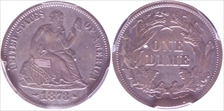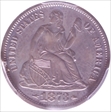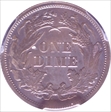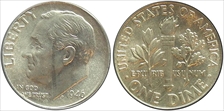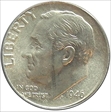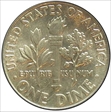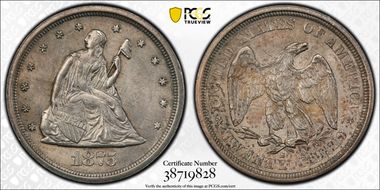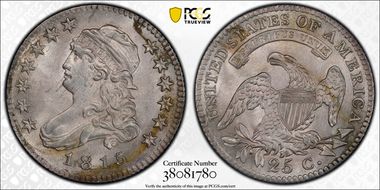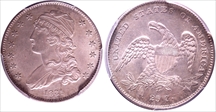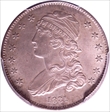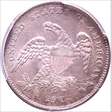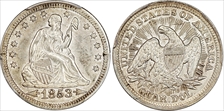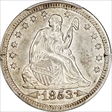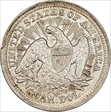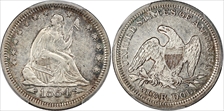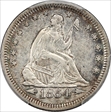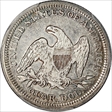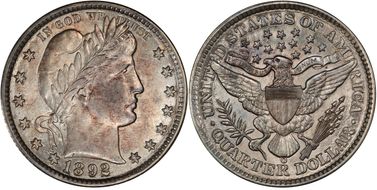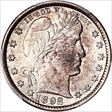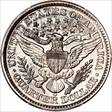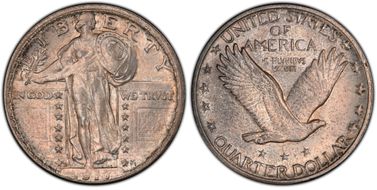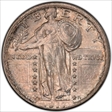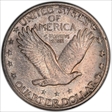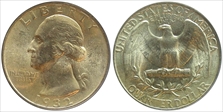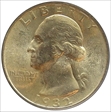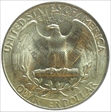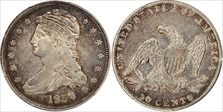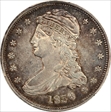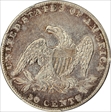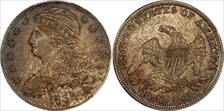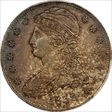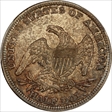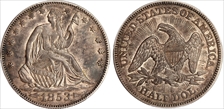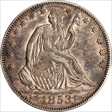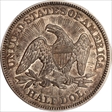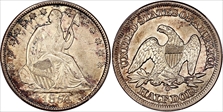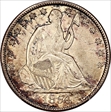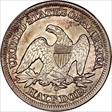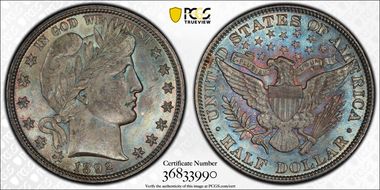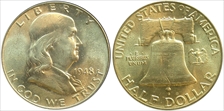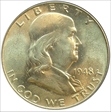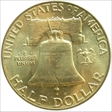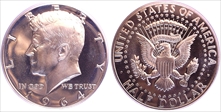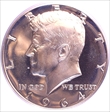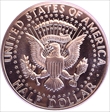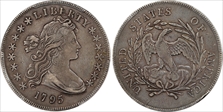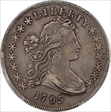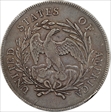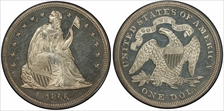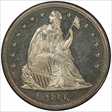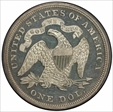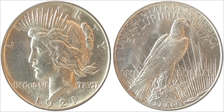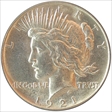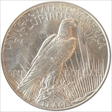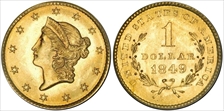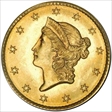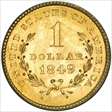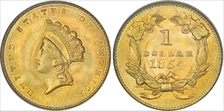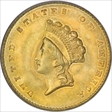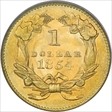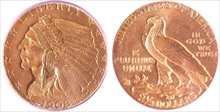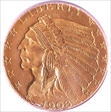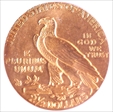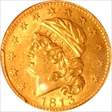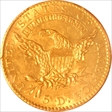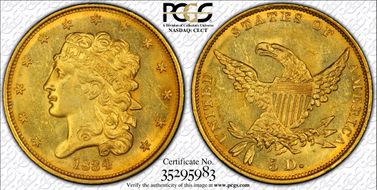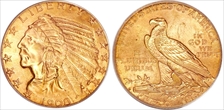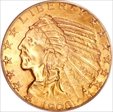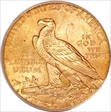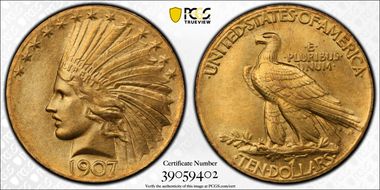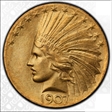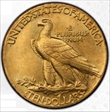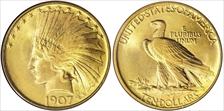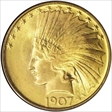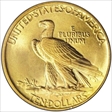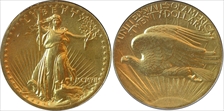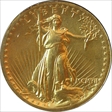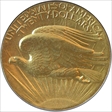The Good Collection 的钱币相册
1794 Liberty Cap Half Cent ex: Dr. James McCallum VF30 { PCGS-4 }. A handsome piece with blended deep copper and medium brown patina on both sides, the latter a bit more pronounced on the reverse. Well centered in strike despite scant denticulation in isolated areas, most devices are boldly defined, and all are discernible. There is softness to the letters LI in LIBERTY and most of those in the words UNITED and CENT. Surfaces show microscopic roughness due to scattered handling marks. Eye-pleasing details of all devices offers a nice example of this early first-year variety. Manley Die State 2.0. C-1a-R3.
1794 Liberty Cap Half Cent ex: Dr. James McCallum VF30 { PCGS-4 }. A handsome piece with blended deep copper and medium brown patina on both sides, the latter a bit more pronounced on the reverse. Well centered in strike despite scant denticulation in isolated areas, most devices are boldly defined, and all are discernible. There is softness to the letters LI in LIBERTY and most of those in the words UNITED and CENT. Surfaces show microscopic roughness due to scattered handling marks. Eye-pleasing details of all devices offers a nice example of this early first-year variety. Manley Die State 2.0. C-1a-R3.
1859 Indian Cent MS64 { PCGS-5 } { CAC } (Aug’2020). This first-year pre-Civil War issue and one-year variety without a shield on the reverse has a nicely struck headdress with good feather definition, a bold “LIBERTY” and four distinct diamonds in the ribbon.
1860 Indian Head Cent MS62 { PCGS-4 } ( Jul'2020) This pre-Civil War Indian Cent is just the second year of the series; AND the first featuring a US shield between the wreath on the reverse. Struck in copper-nickel the olive patina uniformly covers this coin now struck over eight score years ago.
1860 Indian Head Cent MS62 { PCGS-4 } ( Jul'2020) This pre-Civil War Indian Cent is just the second year of the series; AND the first featuring a US shield between the wreath on the reverse. Struck in copper-nickel the olive patina uniformly covers this coin now struck over eight score years ago.
1860 Indian Head Cent MS62 { PCGS-4 } ( Jul'2020) This pre-Civil War Indian Cent is just the second year of the series; AND the first featuring a US shield between the wreath on the reverse. Struck in copper-nickel the olive patina uniformly covers this coin now struck over eight score years ago.
1864 Indian Head Bronze Cent MS64RB { PCGS-3 } { CAC | Eagle Eye Photo Seal } (Aug'2020) This well struck bronze cent is they first year of issue for this variation which would remain unchanged for the next forty-five years. Attractively toned, the fields offer ample reddish copper highlights that offset the handsomely darkened devices. The four diamonds on the ribbon are well defined and details extend to the feather-tips.
1864 Indian Head Bronze Cent MS64RB { PCGS-3 } { CAC | Eagle Eye Photo Seal } (Aug'2020) This well struck bronze cent is they first year of issue for this variation which would remain unchanged for the next forty-five years. Attractively toned, the fields offer ample reddish copper highlights that offset the handsomely darkened devices. The four diamonds on the ribbon are well defined and details extend to the feather-tips.
1864 Indian Head Bronze Cent MS64RB { PCGS-3 } { CAC | Eagle Eye Photo Seal } (Aug'2020) This well struck bronze cent is they first year of issue for this variation which would remain unchanged for the next forty-five years. Attractively toned, the fields offer ample reddish copper highlights that offset the handsomely darkened devices. The four diamonds on the ribbon are well defined and details extend to the feather-tips.
1909 VDB Lincoln Cent MS65RD { PCGS-3 } (Apr'2009) Brilliant red mint-fresh luster and satiny fields adorn both sides of this first year Lincoln Cent which includes the designer's initials on the reverse at 6 o'clock. Public outcry derided the "imposing" initials, and they were removed quickly, and most initial year coins do not contain them.
1909 VDB Lincoln Cent MS65RD { PCGS-3 } (Apr'2009) Brilliant red mint-fresh luster and satiny fields adorn both sides of this first year Lincoln Cent which includes the designer's initials on the reverse at 6 o'clock. Public outcry derided the "imposing" initials, and they were removed quickly, and most initial year coins do not contain them.
1909 VDB Lincoln Cent MS65RD { PCGS-3 } (Apr'2009) Brilliant red mint-fresh luster and satiny fields adorn both sides of this first year Lincoln Cent which includes the designer's initials on the reverse at 6 o'clock. Public outcry derided the "imposing" initials, and they were removed quickly, and most initial year coins do not contain them.
1909 Lincoln Cent MS64BN { PCGS-3 } (Apr'2013) Public outcry about the size of the designer's initials on the reverse being 'too imposing' had them removed for the remainder of this first year, the centennial anniversary of the birth of Abraham Lincoln. This coin has years of that old copper penny patina, but still manages to maintain a solid mint state status.
1909 Lincoln Cent MS64BN { PCGS-3 } (Apr'2013) Public outcry about the size of the designer's initials on the reverse being 'too imposing' had them removed for the remainder of this first year, the centennial anniversary of the birth of Abraham Lincoln. This coin has years of that old copper penny patina, but still manages to maintain a solid mint state status.
1909 Lincoln Cent MS64BN { PCGS-3 } (Apr'2013) Public outcry about the size of the designer's initials on the reverse being 'too imposing' had them removed for the remainder of this first year, the centennial anniversary of the birth of Abraham Lincoln. This coin has years of that old copper penny patina, but still manages to maintain a solid mint state status.
1943 Lincoln Steel Cent MS67 { PCGS-3 } (Nov'2005) This gem cent is a nice high-end clean mint-state Philly-steel (for the type collection). A pleasing mint-state patina has muted the mint-fresh shiny surfaces.
1943 Lincoln Steel Cent MS67 { PCGS-3 } (Nov'2005) This gem cent is a nice high-end clean mint-state Philly-steel (for the type collection). A pleasing mint-state patina has muted the mint-fresh shiny surfaces.
1943 Lincoln Steel Cent MS67 { PCGS-3 } (Nov'2005) This gem cent is a nice high-end clean mint-state Philly-steel (for the type collection). A pleasing mint-state patina has muted the mint-fresh shiny surfaces.
1959 Lincoln Memorial Cent PR67RD { PCGS-4 } This beautifully struck mint-fresh red has deeply reflective mirrors presenting for the first time the Lincoln Memorial on the reverse.
1959 Lincoln Memorial Cent PR67RD { PCGS-4 } This beautifully struck mint-fresh red has deeply reflective mirrors presenting for the first time the Lincoln Memorial on the reverse.
1959 Lincoln Memorial Cent PR67RD { PCGS-4 } This beautifully struck mint-fresh red has deeply reflective mirrors presenting for the first time the Lincoln Memorial on the reverse.
1864 Two Cent Large Motto MS64RB { PCGS-3 } (Nov'2005) Just the faintest glimmer of red on this mostly brown two-pence, complete with the motto "In God We Trust". This was the first coin to bear this motto.
1864 Two Cent Large Motto MS64RB { PCGS-3 } (Nov'2005) Just the faintest glimmer of red on this mostly brown two-pence, complete with the motto "In God We Trust". This was the first coin to bear this motto.
1864 Two Cent Large Motto MS64RB { PCGS-3 } (Nov'2005) Just the faintest glimmer of red on this mostly brown two-pence, complete with the motto "In God We Trust". This was the first coin to bear this motto.
1851 Three Cent Silver Type 1 MS65 { PCGS-4 } (Aug'2020). This introductory year for the "trime" found this tiny coin just 75% silver being placed into circulation featuring a star and shield on the obverse and a Roman Numeral "III" on the reverse. The stylized "C" suggests "CENTS". Later designated as "Type 1", its distinguishing characteristic is the single border of the star from the field; also there are no olive sprig or bundle of arrows above and below the "III". Old-silver toning has diminished the luster some while complimenting the age of the devices.
1851 Three Cent Silver Type 1 MS65 { PCGS-4 } (Aug'2020). This introductory year for the "trime" found this tiny coin just 75% silver being placed into circulation featuring a star and shield on the obverse and a Roman Numeral "III" on the reverse. The stylized "C" suggests "CENTS". Later designated as "Type 1", its distinguishing characteristic is the single border of the star from the field; also there are no olive sprig or bundle of arrows above and below the "III". Old-silver toning has diminished the luster some while complimenting the age of the devices.
1851 Three Cent Silver Type 1 MS65 { PCGS-4 } (Aug'2020). This introductory year for the "trime" found this tiny coin just 75% silver being placed into circulation featuring a star and shield on the obverse and a Roman Numeral "III" on the reverse. The stylized "C" suggests "CENTS". Later designated as "Type 1", its distinguishing characteristic is the single border of the star from the field; also there are no olive sprig or bundle of arrows above and below the "III". Old-silver toning has diminished the luster some while complimenting the age of the devices.
1854 Three Cent Silver Type 2 MS63 { PCGS-4 } (AUG'2020). This second of three designs for a never popular coin upped the silver content to that of other US Silver coins, yielding an even lighter coin than the Type 1. Introducing a laurel above the Roman Numeral "III" and some arrows below it. the large ornate "C" continued to suggest "Cents".
1854 Three Cent Silver Type 2 MS63 { PCGS-4 } (AUG'2020). This second of three designs for a never popular coin upped the silver content to that of other US Silver coins, yielding an even lighter coin than the Type 1. Introducing a laurel above the Roman Numeral "III" and some arrows below it. the large ornate "C" continued to suggest "Cents".
1854 Three Cent Silver Type 2 MS63 { PCGS-4 } (AUG'2020). This second of three designs for a never popular coin upped the silver content to that of other US Silver coins, yielding an even lighter coin than the Type 1. Introducing a laurel above the Roman Numeral "III" and some arrows below it. the large ornate "C" continued to suggest "Cents".
1859 Three Cent Silver (Type 3) MS66 { PCGS-4 } (Aug'2020). This solidly struck PQ gem offers a solid strike and well-defined devices. The difference in the design for the three different types of the series are the number of distinct lines that form the border of the star. This Type-3 first-year-issue has two such lines (as opposed to the Type-2 that has three... go figure).
1859 Three Cent Silver (Type 3) MS66 { PCGS-4 } (Aug'2020). This solidly struck PQ gem offers a solid strike and well-defined devices. The difference in the design for the three different types of the series are the number of distinct lines that form the border of the star. This Type-3 first-year-issue has two such lines (as opposed to the Type-2 that has three... go figure).
1859 Three Cent Silver (Type 3) MS66 { PCGS-4 } (Aug'2020). This solidly struck PQ gem offers a solid strike and well-defined devices. The difference in the design for the three different types of the series are the number of distinct lines that form the border of the star. This Type-3 first-year-issue has two such lines (as opposed to the Type-2 that has three... go figure).
1866 Liberty Shield Nickel (with Rays) MS65 { PCGS-5 } { CAC } (Aug’2020). This nicely struck nickel features the first-year design including rays about the shield presenting an over-crowded design fraught with production issues.
1867 Shield Nickel (No Rays) { PCGS-4 } (Aug'2020). In the second year of this series, the "rays" are removed simplifying the design and enhancing the overall eye appeal. Nice uniform nickel toning covers the piece and the strike is solid giving good detail for all of the lines in the shield.
1867 Shield Nickel (No Rays) { PCGS-4 } (Aug'2020). In the second year of this series, the "rays" are removed simplifying the design and enhancing the overall eye appeal. Nice uniform nickel toning covers the piece and the strike is solid giving good detail for all of the lines in the shield.
1867 Shield Nickel (No Rays) { PCGS-4 } (Aug'2020). In the second year of this series, the "rays" are removed simplifying the design and enhancing the overall eye appeal. Nice uniform nickel toning covers the piece and the strike is solid giving good detail for all of the lines in the shield.
1883 Liberty Head Nickel No CENTS MS65 { PCGS-2 } (Mar'2009) Nice luster on this OGH gem compliments a strike which is solid on this first-year issue original variety sans "CENTS". Some unscrupulous entrepreneurs took to gold-plating these coins and then using them to buy a couple cents worth of merchandise, hoping to get nearly $5 in change. This was the only US coin to be minted without a denomination, a situation which was quickly remedied.
1883 Liberty Head Nickel No CENTS MS65 { PCGS-2 } (Mar'2009) Nice luster on this OGH gem compliments a strike which is solid on this first-year issue original variety sans "CENTS". Some unscrupulous entrepreneurs took to gold-plating these coins and then using them to buy a couple cents worth of merchandise, hoping to get nearly $5 in change. This was the only US coin to be minted without a denomination, a situation which was quickly remedied.
1883 Liberty Head Nickel No CENTS MS65 { PCGS-2 } (Mar'2009) Nice luster on this OGH gem compliments a strike which is solid on this first-year issue original variety sans "CENTS". Some unscrupulous entrepreneurs took to gold-plating these coins and then using them to buy a couple cents worth of merchandise, hoping to get nearly $5 in change. This was the only US coin to be minted without a denomination, a situation which was quickly remedied.
1883 Liberty Head Nickel With CENTS MS64 { PCGS-3 } (Feb'2009) This first year design modification has nice luster, no serious marks, and a die-break through the upper stars on the obverse. "CENTS" was added when con-men gold plated the No Cents variety with gold and tried to pass them off as half eagles.
1883 Liberty Head Nickel With CENTS MS64 { PCGS-3 } (Feb'2009) This first year design modification has nice luster, no serious marks, and a die-break through the upper stars on the obverse. "CENTS" was added when con-men gold plated the No Cents variety with gold and tried to pass them off as half eagles.
1883 Liberty Head Nickel With CENTS MS64 { PCGS-3 } (Feb'2009) This first year design modification has nice luster, no serious marks, and a die-break through the upper stars on the obverse. "CENTS" was added when con-men gold plated the No Cents variety with gold and tried to pass them off as half eagles.
1913 Buffalo Nickel Type 1 MS64 { PCGS-4 } (Apr'2013) A solid strike has good details on both sides, a full horn and clear definition of the buffalo's tail. This variety, with the buffalo standing on the mound was the initial design, found to be lacking in that the denomination as feared to be the first thing to wear off, and so the second variety was introduced this same year to provide it better protection. This is the most common of the two varieties (from all mints). The reverse also has a thirty degree die rotation.
1913 Buffalo Nickel Type 1 MS64 { PCGS-4 } (Apr'2013) A solid strike has good details on both sides, a full horn and clear definition of the buffalo's tail. This variety, with the buffalo standing on the mound was the initial design, found to be lacking in that the denomination as feared to be the first thing to wear off, and so the second variety was introduced this same year to provide it better protection. This is the most common of the two varieties (from all mints). The reverse also has a thirty degree die rotation.
1913 Buffalo Nickel Type 1 MS64 { PCGS-4 } (Apr'2013) A solid strike has good details on both sides, a full horn and clear definition of the buffalo's tail. This variety, with the buffalo standing on the mound was the initial design, found to be lacking in that the denomination as feared to be the first thing to wear off, and so the second variety was introduced this same year to provide it better protection. This is the most common of the two varieties (from all mints). The reverse also has a thirty degree die rotation.
1913 Buffalo Nickel Type 2 MS64 { PCGS-4 } (Apr'2013) There are some attractive underlying toning visible on both sides, including rose, gold, cobalt blue and emerald green. There is also considerable luster from the reverse, which is also rotated about twenty degrees. The design change occurred later in the year, making this the rarer of the the two types from all three mints.
1913 Buffalo Nickel Type 2 MS64 { PCGS-4 } (Apr'2013) There are some attractive underlying toning visible on both sides, including rose, gold, cobalt blue and emerald green. There is also considerable luster from the reverse, which is also rotated about twenty degrees. The design change occurred later in the year, making this the rarer of the the two types from all three mints.
1913 Buffalo Nickel Type 2 MS64 { PCGS-4 } (Apr'2013) There are some attractive underlying toning visible on both sides, including rose, gold, cobalt blue and emerald green. There is also considerable luster from the reverse, which is also rotated about twenty degrees. The design change occurred later in the year, making this the rarer of the the two types from all three mints.
1938-D Jefferson Nickel MS65 { PCGS-3 } (Apr'2013) Pleasing nickel color blankets both sides of this first-year mid-year replacement of the popular Buffalo Nickel. Jefferson was the third American/Statesman to be honored on regular issue coinage of the United States.
1938-D Jefferson Nickel MS65 { PCGS-3 } (Apr'2013) Pleasing nickel color blankets both sides of this first-year mid-year replacement of the popular Buffalo Nickel. Jefferson was the third American/Statesman to be honored on regular issue coinage of the United States.
1938-D Jefferson Nickel MS65 { PCGS-3 } (Apr'2013) Pleasing nickel color blankets both sides of this first-year mid-year replacement of the popular Buffalo Nickel. Jefferson was the third American/Statesman to be honored on regular issue coinage of the United States.
1942-P Jefferson Nickel Type 2 PR64 { PCGS-4 } (Apr'2013) Mid-year, the composition of the nickel was changed to reduce the copper content and eliminate the zinc content and add silver in support of the war effort during WWII. This coin has nice surfaces, clean reflective fields and plenty of luster.
1942-P Jefferson Nickel Type 2 PR64 { PCGS-4 } (Apr'2013) Mid-year, the composition of the nickel was changed to reduce the copper content and eliminate the zinc content and add silver in support of the war effort during WWII. This coin has nice surfaces, clean reflective fields and plenty of luster.
1942-P Jefferson Nickel Type 2 PR64 { PCGS-4 } (Apr'2013) Mid-year, the composition of the nickel was changed to reduce the copper content and eliminate the zinc content and add silver in support of the war effort during WWII. This coin has nice surfaces, clean reflective fields and plenty of luster.
1837 Seated Liberty Half Dime (No Stars, Small Date) AU50 { PCGS-4 } ( AUG’2020). Very appealing silver toning provides dark outlining of devices. Notice the absence of stars in the obverse field, and the left arm free of drapery.
1837 Seated Liberty Half Dime (No Stars, Small Date) AU50 { PCGS-4 } ( AUG’2020). Very appealing silver toning provides dark outlining of devices. Notice the absence of stars in the obverse field, and the left arm free of drapery.
1837 Seated Liberty Half Dime (No Stars, Small Date) AU50 { PCGS-4 } ( AUG’2020). Very appealing silver toning provides dark outlining of devices. Notice the absence of stars in the obverse field, and the left arm free of drapery.
1838 Half Dime No Drapery MS63 { PCGS-3 } (Nov'2005) With somewhat mottled "old-silver" patina, this tiny silver piece has a decent strike and a slight die rotation. Martin Van Buren was president when this piece was issued.
1838 Half Dime No Drapery MS63 { PCGS-3 } (Nov'2005) With somewhat mottled "old-silver" patina, this tiny silver piece has a decent strike and a slight die rotation. Martin Van Buren was president when this piece was issued.
1838 Half Dime No Drapery MS63 { PCGS-3 } (Nov'2005) With somewhat mottled "old-silver" patina, this tiny silver piece has a decent strike and a slight die rotation. Martin Van Buren was president when this piece was issued.
1853 Seated Liberty Half Dime (Arrows) MS63 { PCGS-4 } ( AUG’2020 ). Gorgeous autumn colors of gold, rose, magenta and violet attract attention on this first year design with arrows by the date, denoting the change in silver content for this issue.
1853 Seated Liberty Half Dime (Arrows) MS63 { PCGS-4 } ( AUG’2020 ). Gorgeous autumn colors of gold, rose, magenta and violet attract attention on this first year design with arrows by the date, denoting the change in silver content for this issue.
1853 Seated Liberty Half Dime (Arrows) MS63 { PCGS-4 } ( AUG’2020 ). Gorgeous autumn colors of gold, rose, magenta and violet attract attention on this first year design with arrows by the date, denoting the change in silver content for this issue.
1860 Seated Liberty Half Dime MS66 ex: D.L. Hansen { PCGS-4 } ( Aug’2020 ). This lustrous gem has superb overall eye appeal. Pretty light golden centers are offset with lavender and rose tints around the rims. This is the first year of the new legend-obverse design type with UNITED STATES OF AMERICA surrounding the seated Liberty..
1860 Seated Liberty Half Dime MS66 ex: D.L. Hansen { PCGS-4 } ( Aug’2020 ). This lustrous gem has superb overall eye appeal. Pretty light golden centers are offset with lavender and rose tints around the rims. This is the first year of the new legend-obverse design type with UNITED STATES OF AMERICA surrounding the seated Liberty..
1860 Seated Liberty Half Dime MS66 ex: D.L. Hansen { PCGS-4 } ( Aug’2020 ). This lustrous gem has superb overall eye appeal. Pretty light golden centers are offset with lavender and rose tints around the rims. This is the first year of the new legend-obverse design type with UNITED STATES OF AMERICA surrounding the seated Liberty..
1837 Seated Liberty Dime ( No Stars, Large Date ) AU50 { PCGS-4 } ( Sep’2020). This classic coin features a nice old-silver patina of gun-metal gray on this variety without stars in the obverse field about Miss Liberty. This specimen includes a 15-degree die rotation.
1837 Seated Liberty Dime ( No Stars, Large Date ) AU50 { PCGS-4 } ( Sep’2020). This classic coin features a nice old-silver patina of gun-metal gray on this variety without stars in the obverse field about Miss Liberty. This specimen includes a 15-degree die rotation.
1837 Seated Liberty Dime ( No Stars, Large Date ) AU50 { PCGS-4 } ( Sep’2020). This classic coin features a nice old-silver patina of gun-metal gray on this variety without stars in the obverse field about Miss Liberty. This specimen includes a 15-degree die rotation.
1938 Seated Liberty Dime ( Large Stars, No Drapery ) { PCGS-4 } { CAC } (Sep'2020). Choice example of this first year issue with large stars and no drapery is well-struck and attractively toned.
1853 Seated Liberty Dime (Arrows) MS65 { PCGS-5 }. The arrows by the date of this short-lived variety denotes the change in silver content for this gem dime that shows some orange and rust toning in the periphery and denticles. The strike is good and the fields pristine with ample original mint luster.
1873 Seated Liberty Dime (Arrows) PR64 { PCGS-4 } (Sep’2020). This nicely struck proof specimen shimmers with its iridescent aqua undertones and gun-metal gray toning. This brief variety features arrows by the date marking a reduction in silver content and the legend "UNITED STATES OF AMERICA" borders the upper perimeter of the obverse.
1873 Seated Liberty Dime (Arrows) PR64 { PCGS-4 } (Sep’2020). This nicely struck proof specimen shimmers with its iridescent aqua undertones and gun-metal gray toning. This brief variety features arrows by the date marking a reduction in silver content and the legend "UNITED STATES OF AMERICA" borders the upper perimeter of the obverse.
1873 Seated Liberty Dime (Arrows) PR64 { PCGS-4 } (Sep’2020). This nicely struck proof specimen shimmers with its iridescent aqua undertones and gun-metal gray toning. This brief variety features arrows by the date marking a reduction in silver content and the legend "UNITED STATES OF AMERICA" borders the upper perimeter of the obverse.
1916 Mercury Dime MS65FB { PCGS-4 } (Apr'2013) This dime has an attractive old-silver patina that has maintained a considerable amount of its original mint luster. All of the horizontal and diagonal bands are boldly struck and stand out, and all of the sticks of the fasces are in sharp detail.
1916 Mercury Dime MS65FB { PCGS-4 } (Apr'2013) This dime has an attractive old-silver patina that has maintained a considerable amount of its original mint luster. All of the horizontal and diagonal bands are boldly struck and stand out, and all of the sticks of the fasces are in sharp detail.
1916 Mercury Dime MS65FB { PCGS-4 } (Apr'2013) This dime has an attractive old-silver patina that has maintained a considerable amount of its original mint luster. All of the horizontal and diagonal bands are boldly struck and stand out, and all of the sticks of the fasces are in sharp detail.
1946 Roosevelt Dime MS65FB { PCGS-3 } Ex: Omaha Bank Hoard (Mar'2009) Nice even un-toned silver luster on this "Full Band" designated gem offers up an eye appealing first year issue. Multiple die etching lines appear on this FYI early die state obverse.
1946 Roosevelt Dime MS65FB { PCGS-3 } Ex: Omaha Bank Hoard (Mar'2009) Nice even un-toned silver luster on this "Full Band" designated gem offers up an eye appealing first year issue. Multiple die etching lines appear on this FYI early die state obverse.
1946 Roosevelt Dime MS65FB { PCGS-3 } Ex: Omaha Bank Hoard (Mar'2009) Nice even un-toned silver luster on this "Full Band" designated gem offers up an eye appealing first year issue. Multiple die etching lines appear on this FYI early die state obverse.
1875-S Twenty Cent MS62 { PCGS-5 } (Aug'2020). The "old-silver" toning on this first-year issue from the San Francisco mint compliments the classic design for this short-lived series. Over one million coins of this denomination were struck in California this year, far out-pacing other mints and other years.
1815 Capped Bust Quarter ex: D.L. Hansen MS63 { PCGS-4 }. This coin is a handsome mint state example for this desirable first year of type with boldly struck surfaces featuring eye-pleasing rose-grey patina showing splashes of olive toning throughout.
1931 Capped Bust Quarter (Small Letters) MS62 { PCGS-5 } { CAC }. Attractive classic devices are well struck and details are well defined.
1931 Capped Bust Quarter (Small Letters) MS62 { PCGS-5 } { CAC }. Attractive classic devices are well struck and details are well defined.
1931 Capped Bust Quarter (Small Letters) MS62 { PCGS-5 } { CAC }. Attractive classic devices are well struck and details are well defined.
1853 Seated Liberty Quarter ( Arrows & Rays ) MS62 { PCGS-4 } { CAC } ( Sep’2020 ). This interesting variety features arrows by the date indicating a weight change in silver content, while the rays were dropped from the design after this first year appearance due to wear issues on the reverse. This piece offers nice mint luster.
1853 Seated Liberty Quarter ( Arrows & Rays ) MS62 { PCGS-4 } { CAC } ( Sep’2020 ). This interesting variety features arrows by the date indicating a weight change in silver content, while the rays were dropped from the design after this first year appearance due to wear issues on the reverse. This piece offers nice mint luster.
1853 Seated Liberty Quarter ( Arrows & Rays ) MS62 { PCGS-4 } { CAC } ( Sep’2020 ). This interesting variety features arrows by the date indicating a weight change in silver content, while the rays were dropped from the design after this first year appearance due to wear issues on the reverse. This piece offers nice mint luster.
1854 Seated Liberty Quarter (with Arrows) XF45 { PCGS-4 }. Well struck devices and clean fields presents a mid-century example of this quarter, annotated with arrows about the date to show a change in silver content.
1854 Seated Liberty Quarter (with Arrows) XF45 { PCGS-4 }. Well struck devices and clean fields presents a mid-century example of this quarter, annotated with arrows about the date to show a change in silver content.
1854 Seated Liberty Quarter (with Arrows) XF45 { PCGS-4 }. Well struck devices and clean fields presents a mid-century example of this quarter, annotated with arrows about the date to show a change in silver content.
1892-0 Barber Quarter Dollar MS62 ex: D.L. Hansen { PCGS-4 } (Aug’2020). Classic late nineteenth century design features a large Liberty bust and heraldic eagle. Brilliant silver is offset by deep toning on Liberty’s face on the obverse and among the stars on the reverse. This first-year issue from the New Orleans mint is well-struck.
1892-0 Barber Quarter Dollar MS62 ex: D.L. Hansen { PCGS-4 } (Aug’2020). Classic late nineteenth century design features a large Liberty bust and heraldic eagle. Brilliant silver is offset by deep toning on Liberty’s face on the obverse and among the stars on the reverse. This first-year issue from the New Orleans mint is well-struck.
1892-0 Barber Quarter Dollar MS62 ex: D.L. Hansen { PCGS-4 } (Aug’2020). Classic late nineteenth century design features a large Liberty bust and heraldic eagle. Brilliant silver is offset by deep toning on Liberty’s face on the obverse and among the stars on the reverse. This first-year issue from the New Orleans mint is well-struck.
1917-D Standing Liberty Quarter MS62 { PCGS-4 } (Aug'2020). Victorian modesty prevailed to better protect Miss Liberty, additionally the thirteen stars are rearranged on the reverse, placing three of them below the eagle. Attractive old-silver toning gives depth to the devices.
1917-D Standing Liberty Quarter MS62 { PCGS-4 } (Aug'2020). Victorian modesty prevailed to better protect Miss Liberty, additionally the thirteen stars are rearranged on the reverse, placing three of them below the eagle. Attractive old-silver toning gives depth to the devices.
1917-D Standing Liberty Quarter MS62 { PCGS-4 } (Aug'2020). Victorian modesty prevailed to better protect Miss Liberty, additionally the thirteen stars are rearranged on the reverse, placing three of them below the eagle. Attractive old-silver toning gives depth to the devices.
1932 Washington Quarter MS63 { PCGS-3 } Ex: Omaha Bank Hoard (Mar'2009) Light champagne toning on both sides covers this freshman issue. This one-year issue honoring the first president became an indefinite stay.
1932 Washington Quarter MS63 { PCGS-3 } Ex: Omaha Bank Hoard (Mar'2009) Light champagne toning on both sides covers this freshman issue. This one-year issue honoring the first president became an indefinite stay.
1932 Washington Quarter MS63 { PCGS-3 } Ex: Omaha Bank Hoard (Mar'2009) Light champagne toning on both sides covers this freshman issue. This one-year issue honoring the first president became an indefinite stay.
1836 Capped Bust Half Dollar (Reeded Edge) XF40 { PCGS-4 }. Luster peeks through the old silver-toning on this reeded edge half-dollar. The extremely low mintage of just 1,200 pieces is what really catches the eye on this looker.
1836 Capped Bust Half Dollar (Reeded Edge) XF40 { PCGS-4 }. Luster peeks through the old silver-toning on this reeded edge half-dollar. The extremely low mintage of just 1,200 pieces is what really catches the eye on this looker.
1836 Capped Bust Half Dollar (Reeded Edge) XF40 { PCGS-4 }. Luster peeks through the old silver-toning on this reeded edge half-dollar. The extremely low mintage of just 1,200 pieces is what really catches the eye on this looker.
1838 Capped Liberty Half Dollar (Reeded Edge, HALF DOL) MS62 ex: D.L. Hansen { PCGS-4 }. Nice old-silver toning and overall sharp definition offers eye pleasing example for this first year issue of this brief reeded-edge variety.
1838 Capped Liberty Half Dollar (Reeded Edge, HALF DOL) MS62 ex: D.L. Hansen { PCGS-4 }. Nice old-silver toning and overall sharp definition offers eye pleasing example for this first year issue of this brief reeded-edge variety.
1838 Capped Liberty Half Dollar (Reeded Edge, HALF DOL) MS62 ex: D.L. Hansen { PCGS-4 }. Nice old-silver toning and overall sharp definition offers eye pleasing example for this first year issue of this brief reeded-edge variety.
1853 Seated Liberty Half Dollar (Arrows & Rays) AU50 { PCGS-4 } (Sep’2020). With arrows by the date indicating a change in silver content for the half dollar, this one-year variety features rays behind the eagle on the reverse. This slightly circulated piece offers attractive toning and excellent details.
1853 Seated Liberty Half Dollar (Arrows & Rays) AU50 { PCGS-4 } (Sep’2020). With arrows by the date indicating a change in silver content for the half dollar, this one-year variety features rays behind the eagle on the reverse. This slightly circulated piece offers attractive toning and excellent details.
1853 Seated Liberty Half Dollar (Arrows & Rays) AU50 { PCGS-4 } (Sep’2020). With arrows by the date indicating a change in silver content for the half dollar, this one-year variety features rays behind the eagle on the reverse. This slightly circulated piece offers attractive toning and excellent details.
1854-O Seated Liberty Half Dollar (with Arrows) ex: D.L. Hansen MS64 { PCGS-4 } There is plenty of luster and a bold strike throughout showing off silver central devices and pale gold fields with wisps of indigo and violet toning in the periphery. This popular New Orleans Mint seated half dollar is the first of a desirable two-year type coin.
1854-O Seated Liberty Half Dollar (with Arrows) ex: D.L. Hansen MS64 { PCGS-4 } There is plenty of luster and a bold strike throughout showing off silver central devices and pale gold fields with wisps of indigo and violet toning in the periphery. This popular New Orleans Mint seated half dollar is the first of a desirable two-year type coin.
1854-O Seated Liberty Half Dollar (with Arrows) ex: D.L. Hansen MS64 { PCGS-4 } There is plenty of luster and a bold strike throughout showing off silver central devices and pale gold fields with wisps of indigo and violet toning in the periphery. This popular New Orleans Mint seated half dollar is the first of a desirable two-year type coin.
1892 Barber Half Dollar MS64 ex: D.L. Hansen { PCGS-4 } { CAC } (Aug’2020). Attractive turquoise toning on the obverse attractively complements Liberty; while on the reverse turquoise, violet, rose, orange, red and blue provide an eye-catching sunset backdrop in the field behind the eagle.
1948 Franklin Half Dollar MS64FL { PCGS-3 } Ex: Omaha Bank Hoard (Feb'2009) Very good luster shines on original surfaces, with a good strike and solid bell lines. Uniform champagne toning covers both sides.
1948 Franklin Half Dollar MS64FL { PCGS-3 } Ex: Omaha Bank Hoard (Feb'2009) Very good luster shines on original surfaces, with a good strike and solid bell lines. Uniform champagne toning covers both sides.
1948 Franklin Half Dollar MS64FL { PCGS-3 } Ex: Omaha Bank Hoard (Feb'2009) Very good luster shines on original surfaces, with a good strike and solid bell lines. Uniform champagne toning covers both sides.
1964 Kennedy Half Dollar PR68 { PCGS-2 } (Jul'2020) Lightly frosted devices provide a nice cameo offset that brings the OGH gem to life. Honoring the thirty-fifth president less than one year after his untimely death, this series exudes perhaps the finest in coin design of any honoring former presidents. This first year edition was the only featuring silver without a clad core, making it particularly desirable.
1964 Kennedy Half Dollar PR68 { PCGS-2 } (Jul'2020) Lightly frosted devices provide a nice cameo offset that brings the OGH gem to life. Honoring the thirty-fifth president less than one year after his untimely death, this series exudes perhaps the finest in coin design of any honoring former presidents. This first year edition was the only featuring silver without a clad core, making it particularly desirable.
1964 Kennedy Half Dollar PR68 { PCGS-2 } (Jul'2020) Lightly frosted devices provide a nice cameo offset that brings the OGH gem to life. Honoring the thirty-fifth president less than one year after his untimely death, this series exudes perhaps the finest in coin design of any honoring former presidents. This first year edition was the only featuring silver without a clad core, making it particularly desirable.
1795 Draped Bust Silver Dollar (Centered Bust) XF40 { PCGS-4 }. Attractive light grey surfaces show nice details for the grade on this late eighteenth-century eye-pleaser. This first-year type brings a maturing look to early US coinage. The smaller eagle pre-dates the later larger and more stylized eagles, perhaps appropriate for the fledgling republic beginning to emerge on the world stage.
1795 Draped Bust Silver Dollar (Centered Bust) XF40 { PCGS-4 }. Attractive light grey surfaces show nice details for the grade on this late eighteenth-century eye-pleaser. This first-year type brings a maturing look to early US coinage. The smaller eagle pre-dates the later larger and more stylized eagles, perhaps appropriate for the fledgling republic beginning to emerge on the world stage.
1795 Draped Bust Silver Dollar (Centered Bust) XF40 { PCGS-4 }. Attractive light grey surfaces show nice details for the grade on this late eighteenth-century eye-pleaser. This first-year type brings a maturing look to early US coinage. The smaller eagle pre-dates the later larger and more stylized eagles, perhaps appropriate for the fledgling republic beginning to emerge on the world stage.
1866 Seated Liberty Silver Dollar (Motto) PR63 { PCGS-3 }. Nice reflective mirrors compliment slightly frosted devices on this post-Civil War specimen. There are a couple of pin-prick marks in the field to the left of Liberty's arm.
1866 Seated Liberty Silver Dollar (Motto) PR63 { PCGS-3 }. Nice reflective mirrors compliment slightly frosted devices on this post-Civil War specimen. There are a couple of pin-prick marks in the field to the left of Liberty's arm.
1866 Seated Liberty Silver Dollar (Motto) PR63 { PCGS-3 }. Nice reflective mirrors compliment slightly frosted devices on this post-Civil War specimen. There are a couple of pin-prick marks in the field to the left of Liberty's arm.
1873 Trade Dollar MS64+ { PCGS-5 }. This attractive first-year issue toned trade dollar combines old-silver toning to highlight devices and periphery with cobalt, violet and lilac hues near the rim. Miss Liberty on the obverse stands out with a darker field behind her.
1878 Morgan Dollar Reverse of 1878 MS62 { PCGS-3 } (Jun'1965) This first year issue has seven tail feathers, is brilliantly tone-free with ample mint-state luster. It was one of a group of thirty silver dollars purchased for sixty bucks back in the mid-sixties, which for an eleven year old back then was a fortune.
1878 Morgan Dollar Reverse of 1878 MS62 { PCGS-3 } (Jun'1965) This first year issue has seven tail feathers, is brilliantly tone-free with ample mint-state luster. It was one of a group of thirty silver dollars purchased for sixty bucks back in the mid-sixties, which for an eleven year old back then was a fortune.
1878 Morgan Dollar Reverse of 1878 MS62 { PCGS-3 } (Jun'1965) This first year issue has seven tail feathers, is brilliantly tone-free with ample mint-state luster. It was one of a group of thirty silver dollars purchased for sixty bucks back in the mid-sixties, which for an eleven year old back then was a fortune.
1921 Peace Silver Dollar High Relief MS62 { PCGS-3 } (Nov'2005) This first year, high relief silver dollar, has nice color and reasonable luster; but, as the grade suggests, quite a bit of surface contact no doubt due to the high relief.
1921 Peace Silver Dollar High Relief MS62 { PCGS-3 } (Nov'2005) This first year, high relief silver dollar, has nice color and reasonable luster; but, as the grade suggests, quite a bit of surface contact no doubt due to the high relief.
1921 Peace Silver Dollar High Relief MS62 { PCGS-3 } (Nov'2005) This first year, high relief silver dollar, has nice color and reasonable luster; but, as the grade suggests, quite a bit of surface contact no doubt due to the high relief.
1922 Peace Silver Dollar Low Relief MS62 { PCGS-3 } (Feb'2009) Some marks, as expected for the grade, with a bit of old-silver toning cover this piece of history. Banks didn't like the high relief dollars that didn't stack nicely, and so they came up with this to accommodate them. Unfortunately, details often turn out muted, even on mint state specimens.
1922 Peace Silver Dollar Low Relief MS62 { PCGS-3 } (Feb'2009) Some marks, as expected for the grade, with a bit of old-silver toning cover this piece of history. Banks didn't like the high relief dollars that didn't stack nicely, and so they came up with this to accommodate them. Unfortunately, details often turn out muted, even on mint state specimens.
1922 Peace Silver Dollar Low Relief MS62 { PCGS-3 } (Feb'2009) Some marks, as expected for the grade, with a bit of old-silver toning cover this piece of history. Banks didn't like the high relief dollars that didn't stack nicely, and so they came up with this to accommodate them. Unfortunately, details often turn out muted, even on mint state specimens.
1849 Gold $1 Type One MS65 { PCGS-3 } (May'2008) This first-year transitional issue prominently shows the "L" on Liberty's neckline, for this open wreath variety. A bold strike and satiny luster characterizes this luminous and exquisite butter-yellow beauty. Surfaces show remarkable preservation from an early strike.
1849 Gold $1 Type One MS65 { PCGS-3 } (May'2008) This first-year transitional issue prominently shows the "L" on Liberty's neckline, for this open wreath variety. A bold strike and satiny luster characterizes this luminous and exquisite butter-yellow beauty. Surfaces show remarkable preservation from an early strike.
1849 Gold $1 Type One MS65 { PCGS-3 } (May'2008) This first-year transitional issue prominently shows the "L" on Liberty's neckline, for this open wreath variety. A bold strike and satiny luster characterizes this luminous and exquisite butter-yellow beauty. Surfaces show remarkable preservation from an early strike.
1854 Gold $1 Type Two MS65 Ex: Madison Collection { PCGS-3 } (Jan'2008) Exceptional first year issue Type 2 gold dollar with brilliant apricot-gold toning and mint-green. This gem bears a superior strike for the issue and type that has been traditionally plagued with weak central definition. The Indian's bonnet displays excellent detail, as do all the letters in DOLLAR and digits in the date, and all elements of the wreath, with just a bit of softness in the hair by the temple. The patina is simply outstanding, with vibrant luster adorning both sides. Unusual for this series, is this gem's surfaces unblemished by the typical die-clashes, indicative of a very early strike.
1854 Gold $1 Type Two MS65 Ex: Madison Collection { PCGS-3 } (Jan'2008) Exceptional first year issue Type 2 gold dollar with brilliant apricot-gold toning and mint-green. This gem bears a superior strike for the issue and type that has been traditionally plagued with weak central definition. The Indian's bonnet displays excellent detail, as do all the letters in DOLLAR and digits in the date, and all elements of the wreath, with just a bit of softness in the hair by the temple. The patina is simply outstanding, with vibrant luster adorning both sides. Unusual for this series, is this gem's surfaces unblemished by the typical die-clashes, indicative of a very early strike.
1854 Gold $1 Type Two MS65 Ex: Madison Collection { PCGS-3 } (Jan'2008) Exceptional first year issue Type 2 gold dollar with brilliant apricot-gold toning and mint-green. This gem bears a superior strike for the issue and type that has been traditionally plagued with weak central definition. The Indian's bonnet displays excellent detail, as do all the letters in DOLLAR and digits in the date, and all elements of the wreath, with just a bit of softness in the hair by the temple. The patina is simply outstanding, with vibrant luster adorning both sides. Unusual for this series, is this gem's surfaces unblemished by the typical die-clashes, indicative of a very early strike.
1908 Gold $2.50 Indian MS66 { PCGS-3 } (Jun'2010) First year issue with typical weak strike on the eagle's feathers, this piece shows incredibly unmarred surfaces, with just two small marks worth mentioning, one on each side. There is an outstanding strike on the Indian, with great detail in the headdress and nearly flawless face. Somewhat rare in PQ gem quality for the series, this specimen shows uniform natural gold color and attractive luster.
1908 Gold $2.50 Indian MS66 { PCGS-3 } (Jun'2010) First year issue with typical weak strike on the eagle's feathers, this piece shows incredibly unmarred surfaces, with just two small marks worth mentioning, one on each side. There is an outstanding strike on the Indian, with great detail in the headdress and nearly flawless face. Somewhat rare in PQ gem quality for the series, this specimen shows uniform natural gold color and attractive luster.
1908 Gold $2.50 Indian MS66 { PCGS-3 } (Jun'2010) First year issue with typical weak strike on the eagle's feathers, this piece shows incredibly unmarred surfaces, with just two small marks worth mentioning, one on each side. There is an outstanding strike on the Indian, with great detail in the headdress and nearly flawless face. Somewhat rare in PQ gem quality for the series, this specimen shows uniform natural gold color and attractive luster.
1813 Liberty Cap Half Eagle (Large Size) MS61 { PCGS-5 }. Beautiful lemon-gold surfaces exhibit frosty luster and a sharp strike. Marks are minor and fewer than would be expected for the grade. A first-year issue and the only gold denomination that was being produced by the United States at the time. Minted during a time period of widespread melting so many pieces did not survive. Great eye appeal on this large size bust, sometime referred to as “Fat Head”.
1813 Liberty Cap Half Eagle (Large Size) MS61 { PCGS-5 }. Beautiful lemon-gold surfaces exhibit frosty luster and a sharp strike. Marks are minor and fewer than would be expected for the grade. A first-year issue and the only gold denomination that was being produced by the United States at the time. Minted during a time period of widespread melting so many pieces did not survive. Great eye appeal on this large size bust, sometime referred to as “Fat Head”.
1813 Liberty Cap Half Eagle (Large Size) MS61 { PCGS-5 }. Beautiful lemon-gold surfaces exhibit frosty luster and a sharp strike. Marks are minor and fewer than would be expected for the grade. A first-year issue and the only gold denomination that was being produced by the United States at the time. Minted during a time period of widespread melting so many pieces did not survive. Great eye appeal on this large size bust, sometime referred to as “Fat Head”.
1834 (Plain 4) Gold $5 Classic (Half Eagle) MS63 { PCGS-5 } (Jul'2020). Bright original semi proof-like surfaces offer a very flashy coin that develops an orange-gold hue at the periphery. The strike is solid with well-defined hair, curls and feathers; and the 'original skin' gives this coin exceptional eye appeal featuring mint-fresh gold luster. Liberty’s face is unmarred and there are just a couple minor marks in the reverse field above and to the right of the eagle.
1908-S Gold $5 Indian MS66 { PCGS-2 } (Jan'2010) Lustrous peach-gold surfaces of this OGH PQ gem are splashed with mint-green, orange, and lilac and exhibit well struck design features, including the headdress feathers. The mint mark is bold and distinct. A couple of minor rubs on the upper reverse fields (behind the neck of the eagle) probably limit the grade, but other than these the fields are pristine, and free of any marks typical on the higher raised fields.
1908-S Gold $5 Indian MS66 { PCGS-2 } (Jan'2010) Lustrous peach-gold surfaces of this OGH PQ gem are splashed with mint-green, orange, and lilac and exhibit well struck design features, including the headdress feathers. The mint mark is bold and distinct. A couple of minor rubs on the upper reverse fields (behind the neck of the eagle) probably limit the grade, but other than these the fields are pristine, and free of any marks typical on the higher raised fields.
1908-S Gold $5 Indian MS66 { PCGS-2 } (Jan'2010) Lustrous peach-gold surfaces of this OGH PQ gem are splashed with mint-green, orange, and lilac and exhibit well struck design features, including the headdress feathers. The mint mark is bold and distinct. A couple of minor rubs on the upper reverse fields (behind the neck of the eagle) probably limit the grade, but other than these the fields are pristine, and free of any marks typical on the higher raised fields.
1907 Indian Eagle (Wire Edge - High Relief) MS64 { PCGS-5 }. Uniform light yellow-gold color bathes both sides of this eagle with satiny surfaces. The fields are clean and free of any noticeable marks. The strike is strong particularly in the center on the Indian and Eagle. The natural luster combined with the high-relief devices bring the Indian and Eagle to life.
1907 Indian Eagle (Wire Edge - High Relief) MS64 { PCGS-5 }. Uniform light yellow-gold color bathes both sides of this eagle with satiny surfaces. The fields are clean and free of any noticeable marks. The strike is strong particularly in the center on the Indian and Eagle. The natural luster combined with the high-relief devices bring the Indian and Eagle to life.
1907 Indian Eagle (Wire Edge - High Relief) MS64 { PCGS-5 }. Uniform light yellow-gold color bathes both sides of this eagle with satiny surfaces. The fields are clean and free of any noticeable marks. The strike is strong particularly in the center on the Indian and Eagle. The natural luster combined with the high-relief devices bring the Indian and Eagle to life.
1907 Gold $10 Liberty (No Motto) MS66 { PCGS-3 } (Nov'2007) PQ Gem of this briefly produced gold type coin. The fields are exceptionally preserved, and the devices are also impressively smooth. Boldly struck aside from a hint of merging on the front talon of the back claw. The date has only a trace of strike doubling. A shimmering green-gold beauty from the first year of this attractive series. President Roosevelt opposed the inclusion of IN GOD WE TRUST, since money can be used for any purpose. Congress saw the matter differently.
1907 Gold $10 Liberty (No Motto) MS66 { PCGS-3 } (Nov'2007) PQ Gem of this briefly produced gold type coin. The fields are exceptionally preserved, and the devices are also impressively smooth. Boldly struck aside from a hint of merging on the front talon of the back claw. The date has only a trace of strike doubling. A shimmering green-gold beauty from the first year of this attractive series. President Roosevelt opposed the inclusion of IN GOD WE TRUST, since money can be used for any purpose. Congress saw the matter differently.
1907 Gold $10 Liberty (No Motto) MS66 { PCGS-3 } (Nov'2007) PQ Gem of this briefly produced gold type coin. The fields are exceptionally preserved, and the devices are also impressively smooth. Boldly struck aside from a hint of merging on the front talon of the back claw. The date has only a trace of strike doubling. A shimmering green-gold beauty from the first year of this attractive series. President Roosevelt opposed the inclusion of IN GOD WE TRUST, since money can be used for any purpose. Congress saw the matter differently.
MCMVII (1907) Gold $20 Saint Gaudens High Relief Wire Rim MS62 { PCGS-3 } (May'2006) A couple rim dings limit the grade; but, this ever-popular piece has a nice strike and great high-relief look. The color and luster are very nice and the devices are free of any problem marks.
MCMVII (1907) Gold $20 Saint Gaudens High Relief Wire Rim MS62 { PCGS-3 } (May'2006) A couple rim dings limit the grade; but, this ever-popular piece has a nice strike and great high-relief look. The color and luster are very nice and the devices are free of any problem marks.
MCMVII (1907) Gold $20 Saint Gaudens High Relief Wire Rim MS62 { PCGS-3 } (May'2006) A couple rim dings limit the grade; but, this ever-popular piece has a nice strike and great high-relief look. The color and luster are very nice and the devices are free of any problem marks.




















